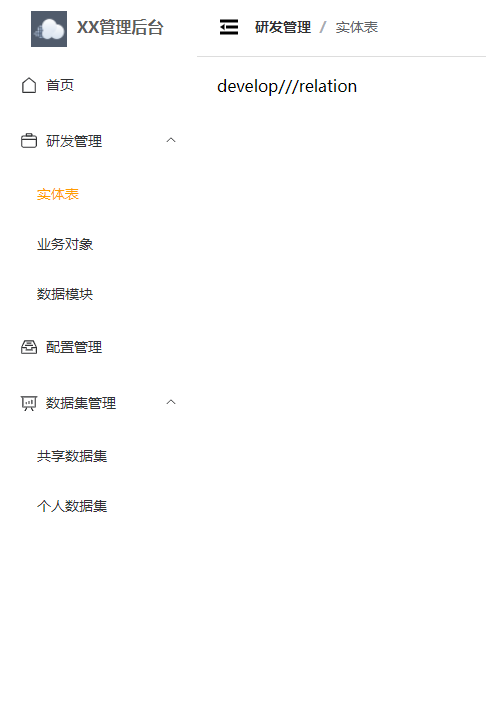设置menuType来区分菜单类型
/**
* @params menuType
* -1 一般为首页 / -> /home 只显示第一个子项
* -2 为无子菜单的菜单项 /config -> /config/person 无上下级,使用一级title
* -3 正常菜单 /system -> /system/1 | /system/2 有上下级
*/
先看看页面效果吧

- type=1
export default [
{
path: '/',
component: Layout,
redirect: '/home',
meta: { icon: 'House', menuType: 1 },
children: [
{
path: 'home',
component: () => import('@/views/home/index.vue'),
meta: { title: '首页' }
},
{
path: '401',
component: () => import('@/views/home/401.vue'),
meta: { title: '401', hideMenu: true }
},
{
path: '404',
component: () => import('@/views/home/404.vue'),
meta: { title: '404', hideMenu: true }
}
]
},
{
path: '/:pathMatch(.*)*',
redirect: '/404',
meta: { hideMenu: true }
}
]
- type=2
export default [
{
path: '/configuration',
component: Layout,
meta: { title: '配置管理', icon: 'MessageBox', menuType: 2 },
redirect: '/configuration/form',
children: [
{
path: 'form',
component: () => import('@/views/configuration/form/index.vue'),
meta: { title: '表单可视化', cache: false }
}
]
}
]
- type=3
export default [
{
path: '/dataset',
component: Layout,
meta: { title: '数据集管理', icon: 'DataAnalysis', menuType: 3 },
redirect: '/dataset/multi',
children: [
{
path: 'multi',
component: () => import('@/views/dataset/multi/index.vue'),
meta: { title: '共享数据集', cache: true }
},
{
path: 'person',
component: () => import('@/views/dataset/person/index.vue'),
meta: { title: '个人数据集', cache: true }
}
]
}
]
区别看得出来吧,看得出来吧,出来吧,吧!
最主要看看menu逻辑
menu:
<template>
<el-scrollbar>
<el-menu
:default-active="activePath"
:collapse="!!collapseMenu"
:collapse-transition="false"
>
<menu-item
v-for="(menu, key) in allRoutes"
:key="key"
:menu="menu"
:path="menu.path"
/>
</el-menu>
</el-scrollbar>
</template>
<script lang="ts" setup>
import { computed } from 'vue'
import { useRouter, useRoute } from 'vue-router'
import MenuItem from './MenuItem.vue'
import { storeToRefs } from 'pinia'
import { SystemStore } from '@/store'
const systemStore = SystemStore()
const { collapseMenu } = storeToRefs(systemStore)
const route = useRoute()
const router = useRouter()
const allRoutes = router.options.routes
const activePath = computed(() => {
return route.path
})
</script>
<style lang="scss" scoped>
.el-menu {
border: none;
}
</style>
menuItem:
<template>
<template v-if="!props.menu.meta?.hideMenu">
<el-sub-menu v-if="props.menu.meta?.menuType === 3" :index="menuPath">
<template #title>
<el-icon>
<component :is="props.menu.meta?.icon"></component>
</el-icon>
<span>{{ props.menu.meta?.title }}</span>
</template>
<template v-for="children in props.menu.children" :key="children.path">
<menu-item
v-if="!children.meta?.hideMenu"
:menu="children"
:path="`${menuPath}/${children.path}`"
/>
</template>
</el-sub-menu>
<router-link v-else :to="menuPath">
<el-menu-item :index="menuPath">
<el-icon v-if="props.menu.meta?.icon">
<component :is="props.menu.meta.icon"></component>
</el-icon>
<template #title>
<span>{{
props.menu.meta?.menuType === 1
? props.menu.children[0].meta?.title
: props.menu.meta?.title
}}</span>
</template>
</el-menu-item>
</router-link>
</template>
</template>
<script lang="ts" setup>
import { computed, PropType } from 'vue'
import { RouteRecordRaw } from 'vue-router'
const props = defineProps({
menu: {
type: Object as PropType<RouteRecordRaw>,
required: true
},
path: {
type: String,
default: ''
}
})
const menuPath = computed(() => {
if ([1, 2].includes(props.menu.meta?.menuType as number)) {
return (
(props.path === '/' ? props.path : props.path + '/') +
props.menu.children![0].path
)
}
return props.path
})
</script>
通过路由meta里面设置hideMenu属性来控制是否在菜单栏展示
menuType
- 为1时(首页),取第一个children的信息
- 为2时取主菜单信息,不展示子菜单
- 为3时全部展示父子菜单
然后就是获取path和取title的逻辑,看看代码就能懂